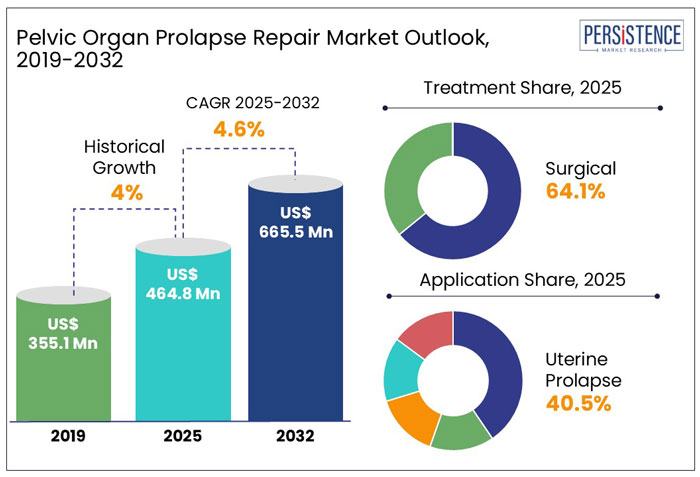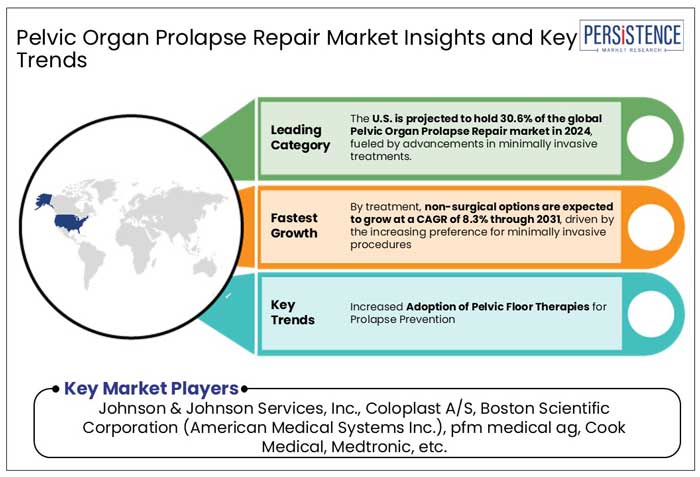Industry: Healthcare
Published Date: March-2025
Format: PPT*, PDF, EXCEL
Delivery Timelines: Contact Sales
Number of Pages: 233
Report ID: PMRREP31735
The global pelvic organ prolapse repair market size is anticipated to rise from US$ 464.8 Mn in 2025 to US$ 665.5 Mn by 2032. It is projected to witness a CAGR of 4.6% from 2025 to 2032.
For millions of women worldwide, pelvic organ prolapse (POP) is more than just a medical condition, it’s a disruption to daily life, impacting mobility, confidence, and overall well-being.
The market for POP repair is rapidly evolving, bringing hope through cutting-edge medical advancements and broader healthcare accessibility.
The demand for treatment is surging, especially in countries with aging populations. With breakthrough innovations, increased awareness, and improved treatment access, the POP repair market is set to transform the lives of millions of women globally.

Key Highlights of the Pelvic Organ Prolapse Repair Market
|
Global Market Attributes |
Key Insights |
|
Pelvic Organ Prolapse Repair Market Size (2025E) |
US$ 464.8 Mn |
|
Market Value Forecast (2032F) |
US$ 665.5 Mn |
|
Projected Growth (CAGR 2025 to 2032) |
4.6% |
|
Historical Market Growth (CAGR 2019 to 2024) |
4.0% |
Rising Geriatric Population Aided Market Demand
During the historical period from 2019 to 2023, the global POP repair market was growing at a steady pace, largely driven by traditional surgical interventions and the rising geriatric population.
Challenges such as limited awareness, post-surgical complications, and the recall of transvaginal mesh products created hesitation among both patients and healthcare providers.
The market primarily relied on open and conventional surgical procedures, which often required extended recovery periods. While non-surgical options like pessary devices were available, they lacked widespread adoption.
Robotic-Assisted Surgeries to Spur Market
Over the forecast period, the market is witnessing an explosion in invasive and robotic-assisted surgeries, which offer faster recovery times and reduced effective risks. The growing emphasis on women’s health initiatives, increased insurance coverage, and technological advancements have accelerated market expansion.
Growth Driver
Aging Population and Rising Cases of Pelvic Floor Disorders Drives Market
Imagine a woman in her late 60s who has spent a lifetime caring for her family, only to find herself struggling with pelvic discomfort and incontinence. Millions of women globally face challenges similar to aging, which naturally weakens pelvic floor muscles.
With the global population of women over 60 expected to reach 1.2 billion by 2030, the prevalence of pelvic organ prolapse (POP) is rising significantly.
As more women seek medical attention to improve their quality of life, hospitals and clinics are witnessing increased consultations and procedures, making this a primary driver for market expansion.
Safety Concerns and Legal Issues Surrounding Mesh Implants Impedes Market Growth
Imagine undergoing a procedure meant to improve your quality of life, only to experience complications that require further corrective surgery. It has been the reality for thousands of women who received transvaginal mesh implants, which have been linked to complications like chronic pain, mesh erosion, and infections.
Due to these concerns, several countries across the globe have restricted or banned certain types of mesh surgeries. Over 100,000 lawsuits have been filed against manufacturers in the U.S., leading to recalls and stricter FDA regulations.
Such legal and regulatory scrutiny has made many surgeons hesitant to recommend mesh-based procedures, shifting the focus to non-mesh alternatives. However, these alternatives often come with longer recovery times, creating a challenging market growth landscape.
The Rise of Minimally Invasive and Robotic-Assisted Surgeries Propels Market Demand
Consider a woman in her late 50s suffering from severe pelvic organ prolapse (POP). A decade ago, her only treatment option would have been an invasive open surgery with weeks of painful recovery.
Today, with robotic-assisted and minimally invasive techniques like laparoscopic sacrocolpopexy, women can undergo surgery with smaller incisions, less post-operative pain, and a shorter hospital stay.
With advancements in AI-driven surgical systems, precision in POP repair continues to improve, making these techniques more widely accepted by surgeons and patients. As hospitals and surgical centres continue to invest in robotic platforms, the market is set for transformative growth.
Treatment Insights
Surgical Treatments dominated the market, accounting for around 64.1% of the total revenue share
The prominence of surgical treatment stems from the effectiveness of surgical repairs in providing long-term relief, particularly for women with severe prolapse that significantly impacts their quality of life.
Surgical procedures such as sacrocolpopexy, colporrhaphy, and hysteropexy offer durable solutions, restoring the normal positioning of pelvic organs.
Such interventions are particularly favored among women who have exhausted non-surgical options, such as pessary use or pelvic floor therapy, and seek a more definitive resolution.
The introduction of robot-assisted surgeries and minimally invasive techniques has further driven adoption, reducing recovery times and post-operative complications.
With an ever-expanding number of women’s health initiatives and surgical advancements, the surgical segment is poised to maintain its stronghold in the market.
Application Insights
Uterine Prolapse Segment Dominates, accounting for approximately 40.5% of the global Market Share
Uterine prolapse occurs when the uterus descends from its normal position into the vaginal canal due to weakened pelvic floor muscles and ligaments.
The physical discomfort and emotional distress associated with uterine prolapse often prompt women to seek medical intervention, contributing to the significant demand in this segment.
Treatment approaches for uterine prolapse are diverse, ranging from non-surgical options like pelvic floor exercises and pessary devices to surgical interventions such as hysterectomy or uterine suspension procedures.
The prominence of the uterine prolapse segment in the POP repair market underscores the importance of continued research, patient education, and the development of innovative treatment modalities to manage this widespread condition effectively.

North America Dominates Due to Advanced Medical Solutions, Commanding Around 30.6% of the Global Market Share
The region's prominence is driven by a combination of factors, including a robust healthcare infrastructure, increased awareness of women's health issues, and the strategic presence of leading medical device manufacturers.
In the United States, for instance, the prevalence of POP has led to increased demand for innovative treatments, with many women seeking solutions that offer both efficacy and minimal invasiveness.
The region's commitment to research and development continually brings cutting-edge therapies, ensuring patients have access to the best care possible.
Aging Population Led to a Rise in Pelvic Floor Disorders in Europe
Europe emerges as a significant player in the POP repair landscape. The continent's aging population has led to a rise in pelvic floor disorders, including POP.
Countries like Germany, France, and the United Kingdom have witnessed a surge in demand for surgical and non-surgical interventions. Government initiatives focusing on women's health have amplified this demand, ensuring patients receive timely and effective treatments.
The European market is characterized by a blend of traditional surgical methods and modern, minimally invasive techniques, catering to a diverse patient population.
Asia Pacific is Anticipated to Witness a Notable Upswing
In the dynamic and diverse Asia Pacific region, the POP repair market is on a notable upswing. Factors such as increasing awareness of women's health, rising healthcare expenditures, and the adoption of advanced medical technologies contribute to this growth.
Countries like China and Japan are at the forefront, integrating state-of-the-art medical treatments with traditional healthcare practices.
The region's emphasis on minimally invasive procedures resonates with patients seeking effective solutions with reduced recovery times. As healthcare infrastructure continues to improve, more women in Asia Pacific are gaining access to essential POP repair services.
The Pelvic Organ Prolapse (POP) Repair Market is a battleground where innovation meets patient care. Leading medical device companies are constantly developing advanced solutions to improve surgical outcomes and patient recovery.
With the growing preference for minimally invasive procedures, companies are investing in robot-assisted surgeries and biocompatible mesh implants to reduce complications and enhance durability.
Recent strategic partnerships and regulatory approvals are shaping the competitive dynamics, pushing companies to refine their offerings.
Meanwhile, emerging players are introducing breakthrough technologies, intensifying the race for market share. As the demand for effective and safer POP treatments rises, companies that prioritize innovation, accessibility, and patient comfort are set to lead the industry’s next phase of growth.
Key Industry Developments
|
Report Attributes |
Details |
|
Historical Data/Actuals |
2019 - 2024 |
|
Forecast Period |
2025 - 2032 |
|
Market Analysis Units |
Value: US$ Bn/Mn, Volume: As applicable |
|
Geographical Coverage |
|
|
Segmental Coverage |
|
|
Competitive Analysis |
|
|
Report Highlights |
|
|
Customization and Pricing |
Available upon request |
By Treatment
By Application
By End User
By Region
To know more about delivery timeline for this report Contact Sales

The market is set to reach US$ 464.8 million in 2025.
Liebherr Group, Konecranes, Manitowoc, are a few leading players.
The industry is estimated to rise at a CAGR of 4.6% through 2032.
The success rate of prolapse repair is around 90%.
The market for is anticipated to reach a valuation of US$ 665.5 million by 2032.